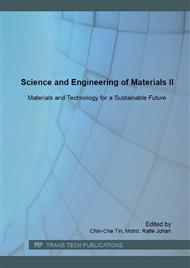[1]
Hekmati, A.H., et al., Effect of needle length, electrospinning distance, and solution concentration on morphological properties of polyamide-6 electrospun nanowebs. Text Res J, 2013: p.0040517512471746.
DOI: 10.1177/0040517512471746
Google Scholar
[2]
Yamaguchi, T., S. Sakai, and K. Kawakami, Application of silicate electrospun nanofibers for cell culture. J Sol-gel Sci Techn, 2008. 48(3): pp.350-355.
DOI: 10.1007/s10971-008-1822-0
Google Scholar
[3]
Pakravan, M., M. -C. Heuzey, and A. Ajji, A fundamental study of chitosan/PEO electrospinning. Polymer, 2011. 52(21): pp.4813-4824.
DOI: 10.1016/j.polymer.2011.08.034
Google Scholar
[4]
Bhardwaj, N. and S.C. Kundu, Electrospinning: a fascinating fiber fabrication technique. Biotechnol Adv, 2010. 28(3): pp.325-347.
DOI: 10.1016/j.biotechadv.2010.01.004
Google Scholar
[5]
Sill, T.J. and H.A. von Recum, Electrospinning: applications in drug delivery and tissue engineering. Biomaterials, 2008. 29(13): p.1989-(2006).
DOI: 10.1016/j.biomaterials.2008.01.011
Google Scholar
[6]
Wang, N., et al., Electrospun nanofibers for air filtration, in Electrospun Nanofibers for Energy and Environmental Applications. 2014, Springer. pp.299-323.
DOI: 10.1007/978-3-642-54160-5_12
Google Scholar
[7]
Bölgen, N., et al., In vivo performance of antibiotic embedded electrospun PCL membranes for prevention of abdominal adhesions. J Biomed Mater Res-B, 2007. 81(2): pp.530-543.
DOI: 10.1002/jbm.b.30694
Google Scholar
[8]
Jose, M.V., et al., Aligned PLGA/HA nanofibrous nanocomposite scaffolds for bone tissue engineering. Acta Biomat, 2009. 5(1): pp.305-315.
DOI: 10.1016/j.actbio.2008.07.019
Google Scholar
[9]
Matthews, J.A., et al., Electrospinning of collagen nanofibers. Biomacromolecules, 2002. 3(2): pp.232-238.
Google Scholar
[10]
Powell, H.M., D.M. Supp, and S.T. Boyce, Influence of electrospun collagen on wound contraction of engineered skin substitutes. Biomaterials, 2008. 29(7): pp.834-843.
DOI: 10.1016/j.biomaterials.2007.10.036
Google Scholar
[11]
Hasani-Sadrabadi, M.M., et al., Novel high-performance nanohybrid polyelectrolyte membranes based on bio-functionalized montmorillonite for fuel cell applications. Chem Commun, 2010. 46(35): pp.6500-6502.
DOI: 10.1039/c0cc01125h
Google Scholar
[12]
Zheng, H., et al., Preparation and characterization of chitosan/poly (vinyl alcohol) blend fibers. J Appl Polym Sci, 2001. 80(13): pp.2558-2565.
DOI: 10.1002/app.1365
Google Scholar
[13]
Xu, J., et al., Preparation of chitosan/PLA blend micro/nanofibers by electrospinning. Mater Lett, 2009. 63(8): pp.658-660.
DOI: 10.1016/j.matlet.2008.12.014
Google Scholar
[14]
Mi, F. -L., et al., In vivo biocompatibility and degradability of a novel injectable-chitosan-based implant. Biomaterials, 2002. 23(1): pp.181-191.
DOI: 10.1016/s0142-9612(01)00094-1
Google Scholar
[15]
Rošic, R., et al., The role of rheology of polymer solutions in predicting nanofiber formation by electrospinning. Eur Polym J, 2012. 48(8): pp.1374-1384.
DOI: 10.1016/j.eurpolymj.2012.05.001
Google Scholar
[16]
Talebian, S., A. Afifi, and H. Khanlou, Fabrication and characterisation of chitosan/poly vinyl alcohol nanofibres via electrospinning. Mater Res Innov, 2014. 18(S6): p. S6-331-S6-335.
DOI: 10.1179/1432891714z.000000000979
Google Scholar
[17]
Jia, Y. -T., et al., Fabrication and characterization of poly (vinyl alcohol)/chitosan blend nanofibers produced by electrospinning method. Carbohyd Polym, 2007. 67(3): pp.403-409.
DOI: 10.1016/j.carbpol.2006.06.010
Google Scholar
[18]
Yan, E., et al., Electrospun polyvinyl alcohol/chitosan composite nanofibers involving Au nanoparticles and their in vitro release properties. Mater Sci Eng C-Bio S, 2013. 33(1): pp.461-465.
DOI: 10.1016/j.msec.2012.09.014
Google Scholar
[19]
Nakane, K., et al., Properties and structure of poly (vinyl alcohol)/silica composites. J Appl Polym Sci, 1999. 74(1): pp.133-138.
DOI: 10.1002/(sici)1097-4628(19991003)74:1<133::aid-app16>3.0.co;2-n
Google Scholar
[20]
Samuels, R.J., Solid state characterization of the structure of chitosan films. J Polym Sci Phys, 1981. 19(7): pp.1081-1105.
DOI: 10.1002/pol.1981.180190706
Google Scholar


